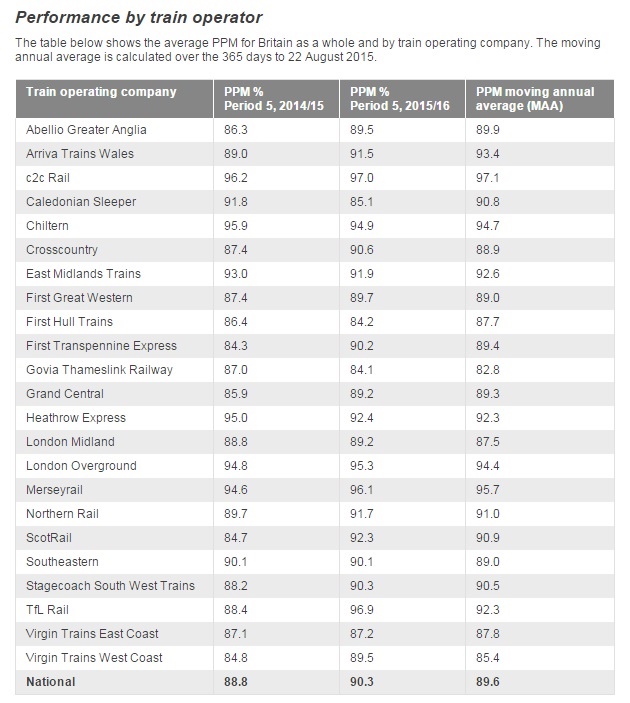15.09.15
National rail performance improves in period 5 after dip in July
National performance on the railways has improved over the past month, with the PPM figure rising to 90.3%.
The Network Rail figure, which covers performance for 26 July to 22 August, is up from the 89.4% recorded during the previous period, and is also up from the 88.8% in period 5 last year.
However performance of the Caledonian Sleeper dropped dramatically after beginning to trend upward under Serco in period 4. The operator’s latest PPM figure for period 5 is 85.1% – a significant decrease from 91.8% in the same period last year, when it was a part of ScotRail, and down from 92.7% in the previous period.
Govia Thameslink Railway (GTR) was the worst performing operator in period 5, with a PPM figure of 84.1%. Despite this its performance was considerably higher than in period 4, during which it reported a PPM of 82.5%.
This is the first time the operator’s performance has been measured since it took in Southern, Gatwick Express and some Southeastern services in late July, when it became the largest single UK franchise.
Southern, now recorded as a sub-operator under GTR, had a steady PPM figure compared to period 4, during which it was been the worst-performing TOC. However GTR’s poor performance was also pulled down by Gatwick Express’s PPM of 79.3% – the only figure below 80% across the rail network.
The highest PPM was again recorded by c2c, which stood at 97% – but while this is 0.8% higher than its performance during the same period last year, it decreased by 0.5% from period 4.
And despite its good performance, other TOCs were close seconds, with TfL Rail raising its PPM dramatically compared to the same period last year – up by 8.5% to 96.9%. TfL also reported significantly less cancellations and lateness, from 4.9% in period 5 last year to 1.5% this year.
The TOC took over the London Liverpool Street to Shenfield metro services from Abellio Greater Anglia on 31 May.
Merseyrail and London Overground also followed on the heels of c2c’s performance, reporting PPM figures of 96.1% and 95.3% respectively. This follows London Overground taking over the London Liverpool Street to Enfield Town/Cheshunt/Chingford services as well as the Romford to Upminster service from Abellio Greater Anglia on 31 May.
First TransPennine Express and ScotRail, which took over from First ScotRail on 1 April, also reported improvements compared to last year’s period 5, with the former up by almost 6% and the latter by 7.6%.
 Click on the image to enlarge it.
Click on the image to enlarge it.
First TransPennine also reported a lower cancellations and significant lateness result, down by almost 2% compared to the same period last year.
These cancellations are recorded if a train is cancelled at origin or en route, if its originating station is changed, if it fails to make a scheduled stop or if it is more than 30 minutes late.
On the other hand, operators First Hull Trains, GTR, East Midlands Trains and Virgin Trains East Coast reported a considerable increase in cancellations and delays. First Hull Trains was particularly negative, with cancellation figures up to 8.6% – the highest of any operator. However, more than half of delays were caused by other operators, while 41% was caused by Network Rail.
Yet this is not reflective of most operators’ delays, with the Delay Split figure, which shows who was responsible for train delays of three minutes or more, once again attributing most delays (59%) to Network Rail due to infrastructure, operations or external issues.